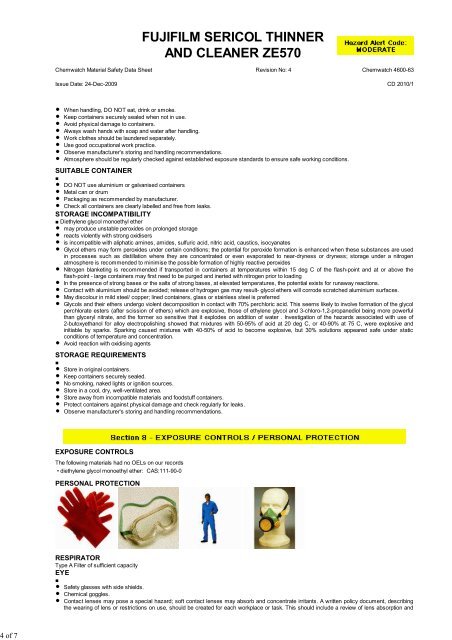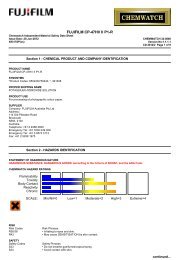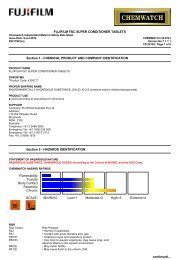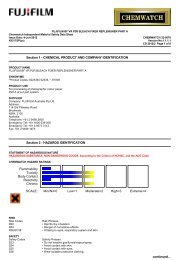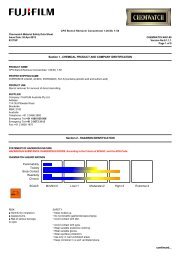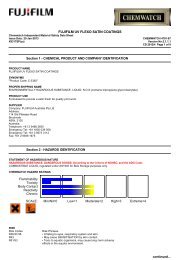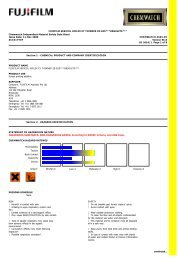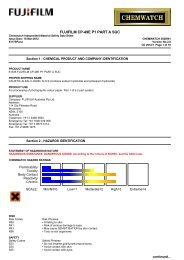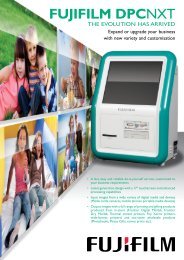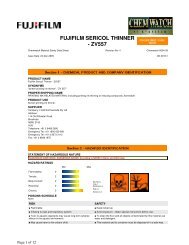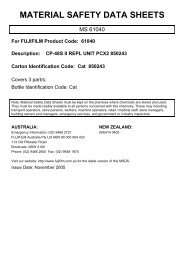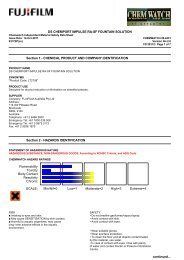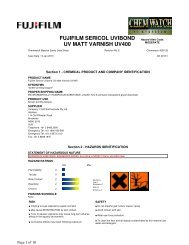fujifilm sericol thinner and cleaner ze570 - FUJIFILM Australia
fujifilm sericol thinner and cleaner ze570 - FUJIFILM Australia
fujifilm sericol thinner and cleaner ze570 - FUJIFILM Australia
You also want an ePaper? Increase the reach of your titles
YUMPU automatically turns print PDFs into web optimized ePapers that Google loves.
4 of 7<br />
<strong>FUJIFILM</strong> SERICOL THINNER<br />
AND CLEANER ZE570<br />
Chemwatch Material Safety Data Sheet Revision No: 4 Chemwatch 4600-63<br />
Issue Date: 24-Dec-2009 CD 2010/1<br />
When h<strong>and</strong>ling, DO NOT eat, drink or smoke.<br />
Keep containers securely sealed when not in use.<br />
Avoid physical damage to containers.<br />
Always wash h<strong>and</strong>s with soap <strong>and</strong> water after h<strong>and</strong>ling.<br />
Work clothes should be laundered separately.<br />
Use good occupational work practice.<br />
Observe manufacturer's storing <strong>and</strong> h<strong>and</strong>ling recommendations.<br />
Atmosphere should be regularly checked against established exposure st<strong>and</strong>ards to ensure safe working conditions.<br />
SUITABLE CONTAINER<br />
■<br />
DO NOT use aluminium or galvanised containers<br />
Metal can or drum<br />
Packaging as recommended by manufacturer.<br />
Check all containers are clearly labelled <strong>and</strong> free from leaks.<br />
STORAGE INCOMPATIBILITY<br />
■ Diethylene glycol monoethyl ether<br />
may produce unstable peroxides on prolonged storage<br />
reacts violently with strong oxidisers<br />
is incompatible with aliphatic amines, amides, sulfuric acid, nitric acid, caustics, isocyanates<br />
Glycol ethers may form peroxides under certain conditions; the potential for peroxide formation is enhanced when these substances are used<br />
in processes such as distillation where they are concentrated or even evaporated to near-dryness or dryness; storage under a nitrogen<br />
atmosphere is recommended to minimise the possible formation of highly reactive peroxides<br />
Nitrogen blanketing is recommended if transported in containers at temperatures within 15 deg C of the flash-point <strong>and</strong> at or above the<br />
flash-point - large containers may first need to be purged <strong>and</strong> inerted with nitrogen prior to loading<br />
In the presence of strong bases or the salts of strong bases, at elevated temperatures, the potential exists for runaway reactions.<br />
Contact with aluminium should be avoided; release of hydrogen gas may result- glycol ethers will corrode scratched aluminium surfaces.<br />
May discolour in mild steel/ copper; lined containers, glass or stainless steel is preferred<br />
Glycols <strong>and</strong> their ethers undergo violent decomposition in contact with 70% perchloric acid. This seems likely to involve formation of the glycol<br />
perchlorate esters (after scission of ethers) which are explosive, those of ethylene glycol <strong>and</strong> 3-chloro-1,2-propanediol being more powerful<br />
than glyceryl nitrate, <strong>and</strong> the former so sensitive that it explodes on addition of water . Investigation of the hazards associated with use of<br />
2-butoxyethanol for alloy electropolishing showed that mixtures with 50-95% of acid at 20 deg C, or 40-90% at 75 C, were explosive <strong>and</strong><br />
initiable by sparks. Sparking caused mixtures with 40-50% of acid to become explosive, but 30% solutions appeared safe under static<br />
conditions of temperature <strong>and</strong> concentration.<br />
Avoid reaction with oxidising agents<br />
STORAGE REQUIREMENTS<br />
■<br />
Store in original containers.<br />
Keep containers securely sealed.<br />
No smoking, naked lights or ignition sources.<br />
Store in a cool, dry, well-ventilated area.<br />
Store away from incompatible materials <strong>and</strong> foodstuff containers.<br />
Protect containers against physical damage <strong>and</strong> check regularly for leaks.<br />
Observe manufacturer's storing <strong>and</strong> h<strong>and</strong>ling recommendations.<br />
EXPOSURE CONTROLS<br />
The following materials had no OELs on our records<br />
• diethylene glycol monoethyl ether: CAS:111-90-0<br />
PERSONAL PROTECTION<br />
RESPIRATOR<br />
Type A Filter of sufficient capacity<br />
EYE<br />
■<br />
Safety glasses with side shields.<br />
Chemical goggles.<br />
Contact lenses may pose a special hazard; soft contact lenses may absorb <strong>and</strong> concentrate irritants. A written policy document, describing<br />
the wearing of lens or restrictions on use, should be created for each workplace or task. This should include a review of lens absorption <strong>and</strong>


